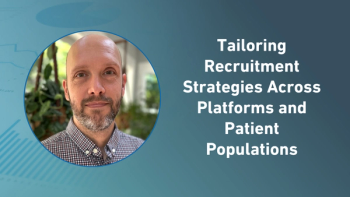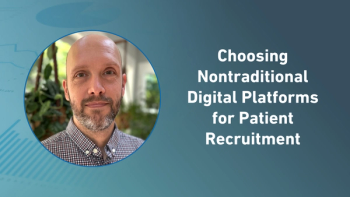
Coalition Offers Ideas for Raising Trial Awareness
The challenges of patient recruiting must be addressed if medical breakthroughs are to be made. Education, simplicity and patient feedback could go a long way in improving the recruitment process.
Why educating the public about clinical trials as an alternative care option is the industry’s next great challenge
The average patient has little knowledge about what it means to participate in a clinical trial, and that’s a problem. This lack of knowledge has the potential to leave room for fears and misunderstandings about trial participation to take hold, causing patients to view clinical research as only a last resort. Not only does this lack of awareness prevent patients from participating in clinical trials that could potentially improve their lives, but also creates obstacles that add significant time and cost to clinical research. Currently, only
11% of U.S. adult patients participate in clinical trials
, according to a University of Michigan study. Those numbers can be even lower among
women
,
minorities
,
children
,
elderly
, and patients in
low income households
who are 27% less likely than patients with higher incomes to participate in trials. And these are just overall averages. Certain disease categories, such as oncology, have even lower rates, with just three to five percent of eligible patients enrolling in trials.
Recruitment already accounts for roughly 30% of the clinical trial timeline
, and in many cases trials fail due to insufficient patient enrollment. This timeframe will likely only get longer as precision medicine further stratifies patient populations and narrows eligibility. In order to shorten these timelines and speed our access to medical breakthroughs, the industry will need to work together to find new solutions for improving patient participation and enrollment in clinical trials. There are a variety of ways to help address these gaps in awareness. A combination of education, better outreach to patients and their physicians, and a more innovative patient-centric approach to recruiting is a solid step in the right direction. That is best achieved when patients, providers, and other industry stakeholders work together to identify obstacles to recruitment, and brainstorm a better approach. To encourage such collaboration, Quintiles hosted a series of events during Clinical Trials Awareness Week with The
Coalition for Clinical Trials Awareness (CCTA)
, where patient advocates, congressional staff and researchers came together to discuss recruiting challenges, and to share lessons learned. Here are some of the ideas and best practices that emerged from those events:
Make it less complicated
Sites like clinicaltrials.gov are meant to make it easier for patients to learn about clinical trial opportunities, but the scientific language and complex format can make the information feel inaccessible and overwhelming. To ease this communication roadblock, event participants discussed tools and strategies to make clinical trial information more user-friendly. For example, new recruiting tools such as
TrialReach
and
Autocruitment
are attempting to ease the complexity around clinical trial discussions by using common language messaging, pushing information out to sites where patients gather, and providing educational tools to help patients understand what the trial will entail before they decide to enroll.
Help physicians help you
Research shows that
in a trial if their physician suggested it, yet just 22% of patients say their provider has ever mentioned research as a care option. Why? Physicians already have limited time with patients, and the additional administrative burden and concerns about referring out their patient can be obstacles that prevent them from talking with patients about clinical trial participation. If sponsors want to engage community physicians in their recruiting efforts, they need to provide more support and resources to get them on board. This might include adding clinical trials into the educational curriculum for medical professionals, guaranteeing that the patient can continue to see their physician during the trial, and for the physician investigator, adding the support of clinical nurse practitioners to complete paperwork and support patients as a way of lessening the impact on the physician’s schedule.
Promote clinical trials as a care option
Focus education efforts on the benefits of research to the patient’s care. For patients with no or sub-optimal insurance coverage, the standard-of-care treatment can be cost-prohibitive. With many conditions, the treatments available may be limited in effectiveness, have undesirable side effects or administration (e.g., injections or frequent dosing). In these situations, participation in a clinical trial can be a lifeline for patients but they need to view the trial as a care option and not an experimental last resort. Education about the benefits of trials, the quality of care they will receive, and the potential impact that treatment could have on their quality of life, and the lives of others suffering from the same disease, can help change their mindset about trials as a balanced alternative to their current treatment.
Support patients participating
For larger research sites, providing ‘patient navigators’ has been particularly helpful in supporting patients participating in clinical research. When patients are faced with a new diagnosis, they often don’t know what questions to ask or how to navigate the large and complex healthcare system. Patient navigators can answer questions and connect patients to educational resources.
Collaborate with patient advocacy groups
For a lot of diseases, patient advocacy groups are the central hub where patients, caregivers, practitioners and key opinion leaders gather to share information and provide support. When sponsors work with these groups it creates new opportunities to communicate with patients about clinical trials, to educate them about the trial process, and to gather feedback about patient-important outcomes that will make the treatment more valuable to the patient community.
Make patients your advocates
Invite patients who have participated in trials to share their stories and answer questions about the trial experience. Hearing firsthand accounts from peers can dispel many of the fears patients have about trial participation, and reduce the stigma attached to being a part of clinical research.
Incorporate patient feedback into trial design
Clinical trials can be time-consuming and particularly challenging for people juggling both work and family life. If you want a patient population to volunteer for your research, you need to listen to their needs and figure out their deal breakers. In some cases, choices like the location of a trial site, timing and frequency of appointments, or how invasive the procedures are can make or break enrollment decisions. By asking patients what they need and adapting the trial accordingly, sponsors can overcome a lot of unnecessary obstacles to participation while also letting the patient community know that their input is valued.
Pursue general awareness efforts
As one patient advocate and long-time community health expert put it: “The time to educate a person about clinical trials is before they need one.” Industry, advocacy groups and local, state and federal health agencies can and should work together to enhance awareness of clinical trials. Ideas discussed at these events ranged from a federally sponsored or assisted campaign similar to organ and blood donation, to simply adding information or prompts on existing government-sponsored health communications. These are a few of the many ideas our participants shared at these events, but the underlying themes are clear: education is critical, simplify the process and incorporate patient feedback into the way trials are run. In this increasingly patient-centric healthcare environment, we all need to think of patients as primary stakeholders in the research process. By engaging them in these conversations and addressing their needs, we can begin to overcome the recruiting challenges that add so much time, cost and risk to the research lifecycle. Jeanne Hecht is Senior Vice President and Global Head of Site and Patient Networks, Quintiles
Newsletter
Stay current in clinical research with Applied Clinical Trials, providing expert insights, regulatory updates, and practical strategies for successful clinical trial design and execution.






.png)



.png)



.png)
.png)
